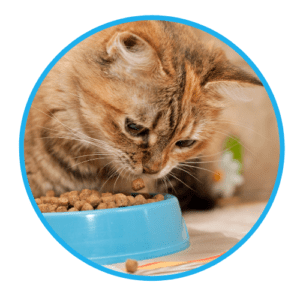
With respect to diet and health the two most important evolutionary facts are:-
First, that cats are obligate carnivores and second, they are of desert origin. While some may find the fact that the domestic cat is an obligate carnivore disturbing and/or objectionable, it is important to bear in mind the practical consequences – cats cannot be vegetarians!
Through evolution cats have become dependent on the specific forms of nutrients found only in animal tissue. Examples include certain fatty acids and vitamins (especially Vitamin A, D, favine and niacin). These nutrients are not found in plant tissue in forms that can be used by cats. Equally important, as an obligate carnivore, cats require high levels of dietary protein with the appropriate balance of amino acids (the building blocks from which proteins are made).
Most mammals including humans and cats use the protein in food to build and maintain tissue and carry out biological reactions. However, unlike other mammals, cats have evolved in such a way as to be “obliged” to also use protein as a source of daily calories! By comparison, humans have evolved to use carbohydrates for the same purpose. Once again, high levels of the correct types of protein which cats need can only be found in animal tissue. In fact diets containing plant protein are not digested as efficiently, and could be harmful or even fatal if fed as the only source of protein because they contain inappropriate levels of certain critical amino acids.
The second evolutionary fact unique to the domestic cat is that its ancestors were of desert origin. Subsequently there are many aspects of cat life that are different than other mammals. On a practical basis, because their desert origin allows them to conserve water more efficiently cats can drink less water per day than a dog of similar size. Fresh drinking water should of course always be provided. However, do not be alarmed if it is not always used. In fact some cats fed moist foods get most of their water directly from the food and their owners rarely see the cat actually drink!
In addition to these unique nutritional requirements, it is also important to consider the normal feeding behaviour of the domestic cat. Left to their own devices a proportion of cats are “nibblers’ and they will eat small meals frequently throughout the day and night. In fact, depending on the individual and the type of food, some cats will eat from 12 – 20 meals a day! This is especially true for dry foods, whereas moist foods (tinned or canned) are usually consumed quickly as larger meals. Furthermore, as anyone that has ever owned a cat can attest, they can be “finicky”! This simply reflects the fact that a cats eating behaviour is influenced by the texture, odour, temperature, and flavour of food. Food temperature influences odour, and like us cats prefer food that “smells good”. Since warm food has more odour or smell it is more readily eaten. This is useful when cats are ill, they can be encouraged to eat simply by warming the food. With the unique nutritional requirements and feeding behaviour of the domestic cat in mind, it is easy to appreciate practical recommendations for feeding. First, fresh clean drinking water should be available all the time.
Early in life kittens need to eat often! They need relatively larger quantities of food because they are growing rapidly, but have limited space in their tiny stomachs!
At eight weeks they need about 4 meals a day.
By 6 months the need for food is decreased as kittens are about 75% “grown-up” and can be fed 2 meals a day.
A good quality kitten food has some advantages over adult cat food since it has been specially formulated. Because of their rapid growth any nutritional “mistakes” made during kittenhood will have more severe consequences. Kitten foods are specially formulated to provide the nutrients needed to meet the demands of rapid growth in a compact form when food intake is limited by tiny stomachs!
Contrary to popular myth, kittens and adult cats do not need milk. In fact after weaning, kittens often lose the ability to digest milk sugar (lactose) by about 12 weeks of age. Therefore, while small amounts may be tolerated, too much can lead to intestinal upset and diarrhoea because it is not digested properly! Lactose-free milk, e.g. Vitapet Pet Milk or Smittten Cat Milk would be a better alternative and can be given to these cats if the owners wish.
Adult cats can be given access to dry food all day, although many cats get too fat when fed in this fashion. Most owners (and cats) prefer to feed small meals of moist food once or twice a day. This is fine as long as the cat also has plenty of opportunity to avoid becoming obese by having plenty of play time! It is important to remember that like us humans, each cat is an individual. Therefore the number of meals offered and the amount and type of food used will vary with individual preferences and activity levels (for example outdoor cats may need more food than less active indoor cats). Also, nutritional requirements and dietary preferences change over the course of the cats lifetime!
Choosing a good quality food from the hundreds available can be difficult. Although some small manufacturers make very good products, unless you are familiar with a specific manufacturer it is best to choose a major brand name. In general, you and your cat get what you pay for! Inexpensive “bargain” foods are really not a bargain in the long run. Good quality foods are generally more expensive but better value, and the most inexpensive way to assure a long, healthy, and happy life is through proper nutrition!
When in doubt, the best source of help is your vet or veterinary nurse.
